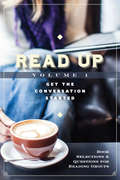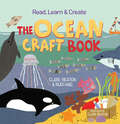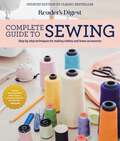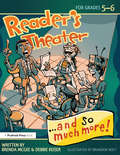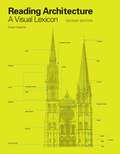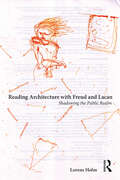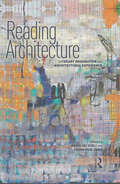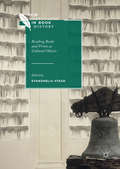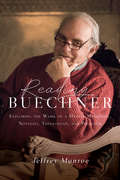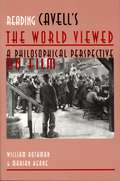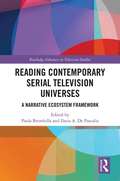- Table View
- List View
Read This if You Want to Take Great Photographs: A Photo Journal (Read This)
by Henry CarrollPhotography is now more popular than ever thanks to the rapid development of digital cameras. Read This If You Want to Take Great Photographs is ideal for this new wave of snapshooters using DSLR, compact system and bridge cameras. It contains no graphs, no techie diagrams and no camera-club jargon. Instead, it inspires readers through iconic images and playful copy, packed with hands-on tips. Split into five sections, the book covers composition, exposure, light, lenses and the art of seeing. Masterpieces by acclaimed photographers – including Henri Cartier-Bresson, Sebastião Salgado, Fay Godwin, Nadav Kander, Daido Moriyama and Martin Parr – serve to illustrate points and encourage readers to try out new ideas. Today’s aspiring photographers want immediacy and see photography as an affordable way of expressing themselves quickly and creatively. This handbook meets their needs, teaching them how to take photographs using professional techniques.
Read Up: Book Selections & Questions for Reading Groups
by Lorraine CaultonRead UpRead Updescriptions, discussion questions, author conversations or excerpts for more than 30 thoughtful books.Read UpRead Up
Read Up: Descriptions & Discussion Questions for More Than 30 Thoughtful Books
by C. Christopher Smith Lorraine CaultonRead Up, Volume 2.Read Up, Volume 2descriptions, discussion questions, author conversations or excerpts for more than 30 thoughtful books.Read UpRead Up
Read, Learn & Create--The Nature Craft Book
by Clare BeatonPerfect for your young explorers and your elementary artists. Make a craft inspired by nature--and learn something, too!What can you create with some backyard objects and tissue paper? Your very own flower crown! Use easy-to-follow directions to make fifteen crafts (and two recipes!) with each one focused on nature. Crafts include fun facts and additional resources, giving covert learning opportunities for your little explorer and reducing screentime.
Read, Learn & Create--The Ocean Craft Book
by Clare Beaton Rudi HaigPerfect for your preK explorers and your elementary artists. Make a craft inspired by ocean--and learn something, too!What can you create with just a cardboard box and some construction paper? Your very own coral reef! Use easy-to-follow directions to make thirteen crafts (and one recipe), each one focused on the ocean. Crafts include fun facts and additional resources, giving covert learning opportunities for your little explorer and reducing screentime.
Reader in Comedy: An Anthology of Theory and Criticism
by Alan Ackerman Magda RomanskaThis unique anthology presents a selection of over seventy of the most important historical essays on comedy, ranging from antiquity to the present, divided into historical periods and arranged chronologically. Across its span it traces the development of comic theory, highlighting the relationships between comedy, politics, economics, philosophy, religion, and other arts and genres. Students of literature and theatre will find this collection an invaluable and accessible guide to writing from Plato and Aristotle through to the twenty-first century, in which special attention has been paid to writings since the start of the twentieth century. The book is arranged in five sections, each featuring an introduction providing concise and informed historical and theoretical frameworks for the texts from the period: - Antiquity and the Middle Ages - The Renaissance - Restoration to Romanticism - The Industrial Age - The Twentieth and Early Twenty-First Centuries Among the many authors included are: Plato, Aristotle, Horace, Donatus, Dante Alighieri, Erasmus, Trissino, Sir Thomas Elyot, Thomas Wilson, Sir Philip Sidney, Ben Jonson, Battista Guarini, Molière, William Congreve, John Dryden, Henry Fielding, Samuel Johnson, Oliver Goldsmith, Jean Paul Richter, William Hazlitt, Charles Lamb, Søren Kierkegaard, Charles Baudelaire, Bernard Shaw, Mark Twain, Henri Bergson, Constance Rourke, Northrop Frye, Jacques Derrida, Mikhail Bakhtin, Georges Bataille, Simon Critchley and Michael North. As the selection demonstrates, from Plato and Aristotle to Henri Bergson and Sigmund Freud, comedy has attracted the attention of serious thinkers. Bringing together diverse theories of comedy from across the ages, the Reader reveals that, far from being peripheral, comedy speaks to the most pragmatic aspects of human life.
Reader's Digest Complete Guide to Sewing: Step By Step Techniques For Making Clothes And Home Accessories
by Reader'S DigestAn indispensable volume for beginning and advanced sewers alike that guides readers through necessary equipment, techniques, fabrics and more.First published in 1978, Reader&’s Digest&’s popular Complete Guide to Sewing has become the standard stich-and-seam reference book for both beginner and seasoned sewers. Now, Reader&’s Digest has refreshed this tried-and-true volume for the modern era, adapting it to current trends while preserving the comprehensive, practical and inspiring content within. Reader&’s Digest Complete Guide to Sewing gives sewers of every experience and comfort level everything they need to know to create the wardrobe of their dreams and beautify their homes with original decorative accents. Clear, simple instructions written by experts in the field tell you what to do and how to do it. Plus, thousands of illustrations and diagrams throughout the book&’s 384 pages illustrate each stage of the process. Key elements of the book include: A detailed list of the basic equipment you&’ll need before getting started sewing. Tips for choosing the right fabric for your project. A step-by-step photo guide that shows you how to take measurements. Instructions in a variety of essential hand-stitching techniques. 20 timeless projects— more than half of them new to this edition—to practice your skills including shirts, dresses, bags, and more. Plus, the book has received endorsements from a variety of trusted sources: &“…and I always recommend the Reader&’s Digest Guide to Sewing. It&’s very comprehensive and very user-friendly.&” —Tim Gunn &“…abundant and precise line art, enticing photographs, simple-to-follow instructions and valuable information on tools, supplies, materials and techniques.&” —The New York Times &“A woman who takes sewing seriously, or who wants to learn to sew, won&’t want to be without this book.&” —Portland Oregon Journal &“Here is everything you always wanted to know about sewing—a veritable encyclopedia of stitching facts.&” —The Austin American Statesman
Reader's Guide to Military History (Reader's Guiides Ser.)
by Charles MessengerThis book contains some 600 entries on a range of topics from ancient Chinese warfare to late 20th-century intervention operations. Designed for a wide variety of users, it encompasses general reviews of aspects of military organization and science, as well as specific wars and conflicts. The book examines naval and air warfare, as well as significant individuals, including commanders, theorists, and war leaders. Each entry includes a listing of additional publications on the topic, accompanied by an article discussing these publications with reference to their particular emphases, strengths, and limitations.
Reader's Theater...and So Much More!: Grades 3-4
by Brenda McGee Debbie Keiser TriskaReader's Theater . . . and So Much More! is written for grades 3-4. This exciting resource contains plays, skits, and independent research activities with an innovative twist for differentiated instruction. This high-interest book of humorous skits and plays is a jumping-off point for research and creativity for students of all ability levels. Each of the reader's theaters comes with suggestions for differentiating and extending the lesson's content. These plays not only provide a legitimate reason for students to reread texts and practice fluency, but they also promote cooperative interaction with peers.Grades 3-4
Reader's Theater...and So Much More!: Grades 5-6
by Brenda McGee Debbie Keiser TriskaReader's Theater . . . and So Much More! is written for grades 5-6. This exciting resource contains plays, skits, and independent research activities with an innovative twist for differentiated instruction. This high-interest book of humorous skits and plays is a jumping-off point for research and creativity for students of all ability levels. Each of the reader's theaters comes with suggestions for differentiating and extending the lesson's content. These plays not only provide a legitimate reason for students to reread texts and practice fluency, but they also promote cooperative interaction with peers.Grades 5-6
Reading About - My Home
by Jim PipeThe Reading About series introduces early readers to non-fiction. Each book is designed to increase reading fluency and combines a narrative text, accessible language and an easy-to-follow format.
Reading American Photographs: Images As History: Mathew Brady to Walker Evans
by Alan TrachtenbergIn this book, Alan Trachtenberg reinterprets some of America's most significant photographs, presenting them not as static images but rather as rich cultural texts suffused with meaning and historical content. Reading American Photographs is lavishly illustrated with the work of such luminaries as Mathew Brady, Timothy O'Sullivan, and Walker Evans--pictures that document the American experience from 1839 to 1938. In an outstanding analysis, Trachtenberg eloquently articulates how the art of photography has both followed and shaped the course of American history, and how images captured decades ago provocatively illuminate the present.
Reading Architectural History
by Dana ArnoldArchitectural history is more than just the study of buildings. Architecture of the past and present remains an essential emblem of a distinctive social system and set of cultural values and as a result it has been the subject of study of a variety of disciplines. But what is architectural history and how should we read it?Reading Architectural History examines the historiographic and socio/cultural implications of the mapping of British architectural history with particular reference to eighteenth - and nineteenth-century Britain. Discursive essays consider a range of writings from biographical and social histories to visual surveys and guidebooks to examine the narrative structures of histories of architecture and their impact on perception adn understanding of the architecture of the past. Alongside this, each chapter cites canonical histories juxtaposed with a range of social and cultural theorists, to reveal that these writings are richer than we have perhaps recognised and that architectural production in this period can in interrogated in the same way as that from more recent past - and can be read in a variety of ways. The essays and texts combine to form an essential course reader for methods and critical approached to architectural history, and more generally as examples of the kind of evidence used in the formation of architectural histories, while also offering a thematic introduction to architecture in Britain and its social and cultural meaning.
Reading Architecture Second Edition: A Visual Lexicon
by Owen HopkinsAnyone with an interest in buildings and the built environment would do well to purchase a copy of Owen Hopkins' book. - MonocleThis innovative and unique book is a visual guide to the buildings that surround us. Architectural features are pinpointed and labelled on images of buildings so that, unlike with other architectural dictionaries, you don't have to know the name before looking it up. Clear line drawings and extensive colour photographs illustrate each of the main building types, from forts to churches, stately homes to skyscrapers. The individual structural elements and materials common to all buildings are then explained, whether in Classical, Gothic or Modernist style. A comprehensive glossary completes the book. This revised edition includes an expanded section on modern structures and materials, as well as the latest styles and concepts from the last ten years. A must for all lovers of architecture and those who would like to learn moreOver 11,000 copies sold in English worldwide Covers all key building types and styles, from cathedrals to skyscrapers, Classical to contemporary. Each building type is illustrated with extensive photographs and annotated drawings Contains a comprehensive glossary of architectural terms
Reading Architecture Second Edition: A Visual Lexicon
by Owen HopkinsAnyone with an interest in buildings and the built environment would do well to purchase a copy of Owen Hopkins' book. - MonocleThis innovative and unique book is a visual guide to the buildings that surround us. Architectural features are pinpointed and labelled on images of buildings so that, unlike with other architectural dictionaries, you don't have to know the name before looking it up. Clear line drawings and extensive colour photographs illustrate each of the main building types, from forts to churches, stately homes to skyscrapers. The individual structural elements and materials common to all buildings are then explained, whether in Classical, Gothic or Modernist style. A comprehensive glossary completes the book. This revised edition includes an expanded section on modern structures and materials, as well as the latest styles and concepts from the last ten years. A must for all lovers of architecture and those who would like to learn moreOver 11,000 copies sold in English worldwide Covers all key building types and styles, from cathedrals to skyscrapers, Classical to contemporary. Each building type is illustrated with extensive photographs and annotated drawings Contains a comprehensive glossary of architectural terms
Reading Architecture and Culture: Researching Buildings, Spaces and Documents
by Adam SharrArchitecture displays the values involved in its inhabitation, construction, procurement and design. It traces the thinking of the individuals who have participated in it, their relationships, and their involvement in the cultures where they lived and worked. In this way, buildings, their details, and the documents used to make them, can be read closely for cultural insights. Introducing the idea of reading buildings as cultural artefacts, this book presents perceptive readings by eminent writers which demonstrate the power of this approach. The chapters show that close readings of architecture and its materials can test commonplace assumptions, help architects to appreciate the contexts in which they work, and indicate ways to think more astutely about design. The readings collected in this innovative and accessible book address buildings, specifications and photographs. They range in time from the fifteenth century – examining the only surviving drawing made by Leon Battista Alberti – to the recent past – projects completed by Norman Foster in 2006 and Herzog and De Meuron in 2008. They range geographically from France to Puerto Rico to Kazakhstan and they range in fame from buildings celebrated by critics to house extensions and motorway service areas. Taken together, these essays demonstrate important research methods which yield powerful insights for designers, critics and historians, and lessons for students.
Reading Architecture with Freud and Lacan: Shadowing the Public Realm
by Lorens HolmReading Architecture with Freud and Lacan: Shadowing the Public Realm methodically outlines key concepts in psychoanalytic discourse by reading them against key modern and post-modern architects. It begins with what is, arguably, the central concept for each discipline by putting the unconscious in a dialectic relation to space. Each subsequent chapter begins with a detail in architectural discourse, a kind of provocation that anchors each excursion into the thought of Freud and Lacan. The text is cyclical, episodic, and cloudlike rather than expository; the intention is not simply to explain the concept of the unconscious but, to different degrees, perform it in the text. The book offers powerful critiques of current planning practice, which has no tools to address our attachment to places. It concludes with powerful critiques of our incapacity to change the environmentally damaging ways we live our lives, which is an effect of our incapacity to recognise the presence of the death drive in our nature. The text is an extended thesis – spanning the chapters – that the field of the Other is the common grammar that organises subjects into civilisations, which has consequences for how we treat the public realm in architecture, politics, and the city. The field of the Other is a slightly different slice through the urban social world. It shadows – but does not correspond exactly to – more familiar categories like private/public, inside/outside, figure/ground, or piazza/boulevard. Reading Architecture with Freud and Lacan will be an essential resource to anyone interested in how the environment we build is a reflection of our desire. Psychoanalysis is one of the great humanist discourses of the 20th century and this book will be a valuable reference to the humanist in architects, planners, and social scientists, whether they are students, professionals, or amateurs. It will appeal to historians of the 20th century, and to psychoanalysts and architects who are interested in how their respective discourses interdigitate with each other and with other discourses.
Reading Architecture: A Visual Lexicon
by Owen HopkinsThis innovative and unique book is a visual guide to the buildings that surround us, naming all the visible architectural features so that, unlike other architectural dictionaries, the reader doesn't have to know the name before looking it up. Clear line drawings and extensive colour photographs illustrate each of the main building types, from forts to churches, stately homes to skyscrapers. The individual structural elements and materials common to all buildings are then explained, whether in Classical, Gothic or Modernist style, before delving into the inner architectural details such as doors and windows, roofs and staircases. A comprehensive glossary completes the book. An original and accessible take on the architectural dictionary, this book takes you on a visual tour of the buildings around us, and will be useful not only to students but to anyone with a general interest in architecture.
Reading Architecture: A Visual Lexicon
by Owen HopkinsThis innovative and unique book is a visual guide to the buildings that surround us, naming all the visible architectural features so that, unlike other architectural dictionaries, the reader doesn't have to know the name before looking it up. Clear line drawings and extensive colour photographs illustrate each of the main building types, from forts to churches, stately homes to skyscrapers. The individual structural elements and materials common to all buildings are then explained, whether in Classical, Gothic or Modernist style, before delving into the inner architectural details such as doors and windows, roofs and staircases. A comprehensive glossary completes the book. An original and accessible take on the architectural dictionary, this book takes you on a visual tour of the buildings around us, and will be useful not only to students but to anyone with a general interest in architecture.
Reading Architecture: Literary Imagination and Architectural Experience
by Angeliki Sioli Yoonchun JungWhy write instead of draw when it comes to architecture? Why rely on literary pieces instead of architectural treatises and writings when it comes to the of study buildings and urban environments? Why rely on literary techniques and accounts instead of architectural practices and analysis when it comes to academic research and educational projects? Why trust authors and writers instead of sociologists or scientists when it comes to planning for the future of cities? This book builds on the existing interdisciplinary bibliography on architecture and literature, but prioritizes literature’s capacity to talk about the lived experience of place and the premise that literary language can often express the inexpressible. It sheds light on the importance of a literary instead of a pictorial imagination for architects and it looks into four contemporary architectural subjects through a wide variety of literary works. Drawing on novels that engage cities from around the world, the book reveals aspects of urban space to which other means of architectural representation are blind. Whether through novels that employ historical buildings or sites interpreted through specific literary methods, it suggests a range of methodologies for contemporary architectural academic research. By exploring the power of narrative language in conveying the experience of lived space, it discusses its potential for architectural design and pedagogy. Questioning the massive architectural production of today’s globalized capital-driven world, it turns to literature for ways to understand, resist or suggest alternative paths for architectural practice. Despite literature’s fictional character, the essays of this volume reveal true dimensions of and for places beyond their historical, social and political reality; dimensions of utmost importance for architects, urban planners, historians and theoreticians nowadays.
Reading Books and Prints as Cultural Objects
by Evanghelia SteadThis book contributes significantly to book, image and media studies from an interdisciplinary, comparative point of view. Its broad perspective spans medieval manuscripts to e-readers. Inventive methodology offers numerous insights into visual, manuscript and print culture: material objects relate to meaning and reading processes; images and texts are examined in varied associations; the symbolic, representational and cultural agency of books and prints is brought forward. An introduction substantiates methods and approaches, ten chapters follow along media lines: from manuscripts to prints, printed books, and e-readers. Eleven contributors from six countries challenge the idea of a unified field, revealing the role of books and prints in transformation and circulation between varying cultural trends, 'high' and 'low'. Mostly Europe-based, the collection offers book and print professionals, academics and graduates, models for future research, imaginatively combining material culture with archival data, cultural and reading theories with historical patterns.
Reading Buechner: Exploring the Work of a Master Memoirist, Novelist, Theologian, and Preacher
by Jeffrey MunroeFrederick Buechner is one of the most gifted writers of his generation, and his legacy casts a long shadow over Christian letters today.
Reading Cavell's The World Viewed: A Philosophical Perspective on Film
by Marian Keane William RothmanIn their thoughtful study of one of Stanley Cavell's greatest yet most neglected books, William Rothman and Marian Keane address this eminent philosopher's many readers, from a variety of disciplines, who have neither understood why he has given film so much attention, nor grasped the place of The World Viewed within the totality of his writings about film. Rothman and Keane also reintroduce The World Viewed to the field of film studies. When the new field entered universities in the late 1960s, it predicated its legitimacy on the conviction that the medium's artistic achievements called for serious criticism and on the corollary conviction that no existing field was capable of the criticism filmed called for. The study of film needed to found itself, intellectually, upon a philosophical investigation of the conditions of the medium and art of film. Such was the challenge The World Viewed took upon itself. However, film studies opted to embrace theory as a higher authority than our experiences of movies, divorcing itself from the philosophical perspective of self-reflection apart from which, The World Viewed teaches, we cannot know what movies mean, or what they are. Rotham and Keane now argue that the poststructuralist theories that dominated film studies for a quarter of a century no longer compel conviction, Cavell's brilliant and beautiful book can provide a sense of liberation to a field that has forsaken its original calling. read in a way that acknowledges its philosophical achievement, The World Viewed can show the field a way to move forward by rediscovering its passion for the art of film. Reading Cavell's The World Viewed will prove invaluable to scholars and students of film and philosophy, and to those in other fields, such as literary studies and American studies, who have found Cavell's work provocative and fruitful.
Reading Contemporary Performance: Theatricality Across Genres
by Meiling Cheng Gabrielle H. CodyAs the nature of contemporary performance continues to expand into new forms, genres and media, it requires an increasingly diverse vocabulary. Reading Contemporary Performance provides students, critics and creators with a rich understanding of the key terms and ideas that are central to any discussion of this evolving theatricality. Specially commissioned entries from a wealth of contributors map out the many and varied ways of discussing performance in all of its forms – from theatrical and site-specific performances to live and New Media art. The book is divided into two sections: Concepts - Key terms and ideas arranged according to the five characteristic elements of performance art: time; space; action; performer; audience. Methodologies and Turning Points - The seminal theories and ways of reading performance, such as postmodernism, epic theatre, feminisms, happenings and animal studies. Case Studies – entries in both sections are accompanied by short studies of specific performances and events, demonstrating creative examples of the ideas and issues in question. Three different introductory essays provide multiple entry points into the discussion of contemporary performance, and cross-references for each entry also allow the plotting of one’s own pathway. Reading Contemporary Performance is an invaluable guide, providing not just a solid set of familiarities, but an exploration and contextualisation of this broad and vital field.
Reading Contemporary Serial Television Universes: A Narrative Ecosystem Framework (Routledge Advances in Television Studies)
by Paola Brembilla Ilaria A. De PascalisReading Contemporary Serial Television Universes provides a new framework—the metaphor of the narrative ecosystem—for the analysis of serial television narratives. Contributors use this metaphor to address the ever-expanding and evolving structure of narratives far beyond their usual spatial and temporal borders, in general and in reference to specific series. Other scholarly approaches consider each narrative as composed of modular elements, which combine to create a bigger picture. The narrative ecosystem approach, on the other hand, argues that each portion of the narrative world contains all of the main elements that characterize the world as a whole, such as narrative tensions, production structures, creative dynamics and functions. The volume details the implications of the narrative ecosystem for narrative theory and the study of seriality, audiences and fandoms, production, and the analysis of the products themselves.

